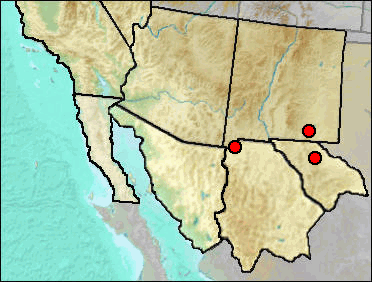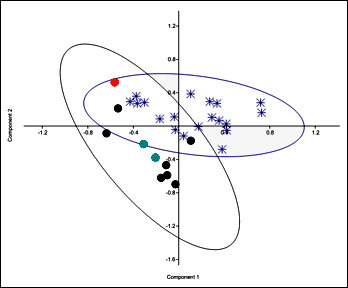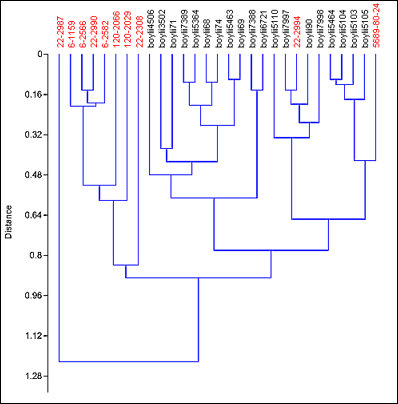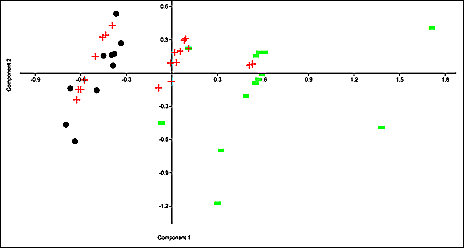Class Mammalia
Order Rodentia
Family Cricetidae
Subfamily Neotominae
Genus Peromyscus

The present geographic range of Peromyscus boylii is from northern California to the Panhandle of Texas and south into Central America. It occurs throughout our region with a wide elevational range. It most commonly is associated with scrub oaks. In Guadalupe Mountains National Park, Cornely et al. (1981) found P. boylii from about 1295 m to over 2430 m; that is, from desert bajadas to the high-elevation montane vegetation; it also was commonly associated with rocky habitats.
Peromyscus boylii characteristically has an incisor base capsule with no distinct bulge; it has no anteroconid indentation or, at most, an extremely shallow indentation. This mouse is very similar to the White-ankled Mouse (P. pectoralis) and specimens of the two species are easily confused.

Research on UTEP fossil specimens of Peromyscus in August 2011 has resulted in identification of relatively few of this species and suggests that individuals east of the Guadalupe Mountains ("Guadalupe group" for discussion purposes) differed from current regional populations (Figs. 1, 2), primarily by smaller size. Few fossils are identified without qualification. Four specimens (one queried) are from Animal Fair, Dry Cave (UTEP Loc. 22); all are from strata thought to be pre-full glacial. Four other specimens are available from Dry Cave: three (two cf., one ?) from Harris' Pocket (UTEP Loc 6, ca. 14.5 ka BP) and one queried from Stalag 17 (UTEP Loc. 23, ca. 11.9 ka BP).
Fig. 1. Principal components plot of modern (asterisk) and fossil (disc) specimens identified as P. boylii. The red disc represents the specimen from U-Bar Cave; blue-green discs are Holocene specimens excavated from Big Manhole Cave, UTEP Loc. 120 (Lear and Harris 2007); and black discs represent specimens from Dry Cave. Ellipses are 95% ellipses.

Fig. 2. Cluster analysis also shows the relationships between the fossil (red) and modern specimens.
The well pronounced differences between the fossil sample from the Guadalupe Mountains region and the modern sample of P. boylii are well shown in figs. 1 and 2. The most likely reason other than sample error are small evolutionary shifts in population parameters as the populations track ecological changes of the late Pleistocene and Holocene. If this is the case, the question remains as to whether P. boylii or P. pectoralis is the species involved. Figure 3 indicates that, in a comparison with the two modern species, the fossils clearly are more akin to P. boylii.
Presence ("cf." in view of uncertainty of relationship with P. boylii) of members of the Guadalupe group in Harris' Pocket seems secure as does presence in the Animal Fair site. In the latter site, age increases with depth and with distance from grid A. The taxon is recorded from the likely pre-pleniglacial units grid C, level 3, and grid D, levels 1-2, 5, and 6; it is not recorded from the near-pleniglacial grids A or B, where only P. maniculatus has been identified. Stalag 17 has a queried occurrence, but appears to fit with other members. A single specimen from U-Bar Cave (UTEP 5689) is tentatively identified as P. boylii from apparent mid-Wisconsin deposits; however, the remainder of the identified, little-enlarged capsule specimens from the site are P. nasutus, and the possibility of mis-identification of the specimen cannot be discarded.
Fig. 3. Principal components plot of modern P. boylii (red crosses), P. pectoralis (green rectangles), and the fossils (black discs).

Sites.
Mid Wisconsin: U-Bar Cave (UTEP: ?).
Mid/Late Wisconsin: Animal Fair (UTEP: cf.); Tsuma Properties, San Clemente (Jefferson 2014).
Late Wisconsin: Harris' Pocket (UTEP: cf.).
Late Wisconsin/Holocene: Fowlkes Cave (Dalquest and Stangl 1984b).
Withdrawn.
Early/Early-Mid Wisconsin: Lost Valley (Harris 1993c).
Late Wisconsin: Bison Chamber (Harris 1993c: ?).
Literature. Cornely et al. 1981; Dalquest and Stangl 1984b; Harris 1993c; Jefferson 2014; Lear and Harris 2007.
Last Update: 9 Mar 2013